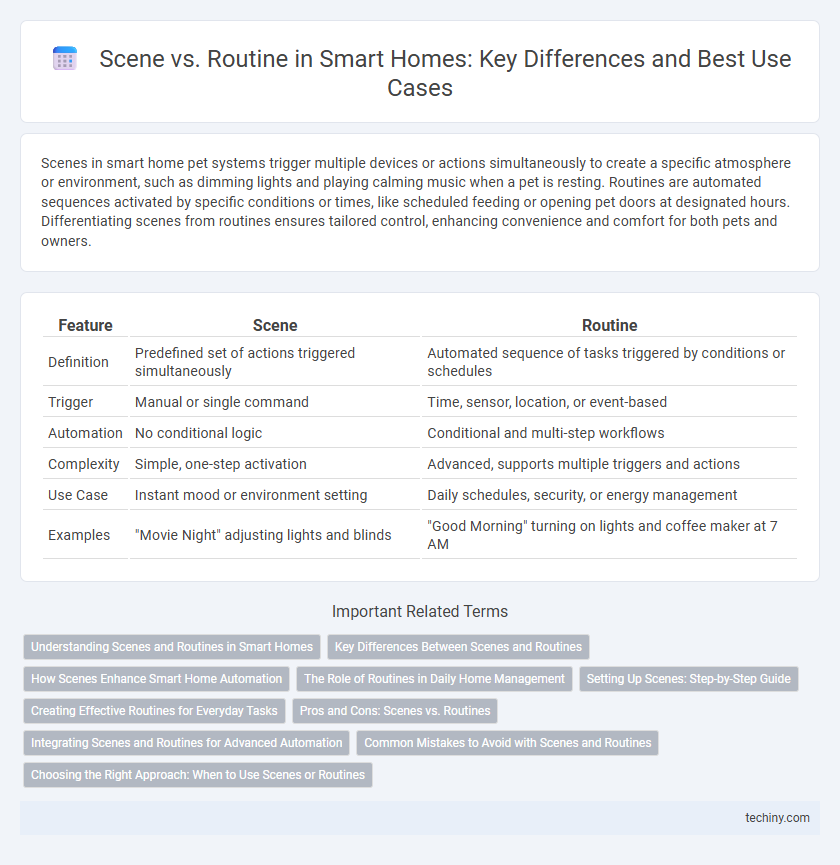Scenes in smart home pet systems trigger multiple devices or actions simultaneously to create a specific atmosphere or environment, such as dimming lights and playing calming music when a pet is resting. Routines are automated sequences activated by specific conditions or times, like scheduled feeding or opening pet doors at designated hours. Differentiating scenes from routines ensures tailored control, enhancing convenience and comfort for both pets and owners.
Table of Comparison
| Feature | Scene | Routine |
|---|---|---|
| Definition | Predefined set of actions triggered simultaneously | Automated sequence of tasks triggered by conditions or schedules |
| Trigger | Manual or single command | Time, sensor, location, or event-based |
| Automation | No conditional logic | Conditional and multi-step workflows |
| Complexity | Simple, one-step activation | Advanced, supports multiple triggers and actions |
| Use Case | Instant mood or environment setting | Daily schedules, security, or energy management |
| Examples | "Movie Night" adjusting lights and blinds | "Good Morning" turning on lights and coffee maker at 7 AM |
Understanding Scenes and Routines in Smart Homes
Scenes in smart homes allow users to create a set of predefined actions triggered simultaneously, such as turning off lights and locking doors with a single command. Routines expand on this concept by enabling automated schedules or conditions, like activating heating at sunset or adjusting blinds based on room temperature. Understanding the distinction between scenes and routines empowers homeowners to customize automation for convenience, energy efficiency, and enhanced security.
Key Differences Between Scenes and Routines
Scenes in smart homes allow users to control multiple devices simultaneously with a single command, creating a specific ambiance or setting, while routines automate a sequence of actions triggered by time, sensor detection, or user activity. Scenes are typically manually activated and focus on device state configurations, whereas routines often include conditional logic and can operate automatically without user intervention. Understanding these distinctions helps optimize smart home customization and efficiency by choosing the right method for individual needs.
How Scenes Enhance Smart Home Automation
Scenes enhance smart home automation by triggering multiple devices simultaneously based on a single command, creating a cohesive environment tailored to specific activities. Unlike routines that often operate on schedules or triggers, scenes offer instant ambiance adjustments, such as dimming lights, adjusting thermostats, and playing music together. This seamless control optimizes energy efficiency, comfort, and convenience, making smart homes more responsive to user preferences.
The Role of Routines in Daily Home Management
Routines in smart home systems automate sequences of actions based on time, location, or device triggers, streamlining daily home management by reducing manual intervention. Unlike scenes, which activate a specific set of device states instantly, routines optimize energy usage, enhance security, and improve convenience through repetitive, conditional automation. Integrating routines with AI-driven sensors further personalizes home environments, adapting lighting, temperature, and appliance control to occupant habits and preferences.
Setting Up Scenes: Step-by-Step Guide
Setting up scenes in a smart home involves selecting multiple devices and configuring their states to create a desired ambiance or function, such as adjusting lighting, thermostats, and music with a single command. Users typically start by choosing a scene name, followed by specifying device actions like dimming lights to 50%, setting the thermostat to 72degF, and playing a favorite playlist. This step-by-step process enhances convenience and personalization, streamlining complex automation into one seamless experience.
Creating Effective Routines for Everyday Tasks
Creating effective routines in a smart home involves automating sequences of actions triggered by specific conditions, optimizing daily efficiency and comfort. Unlike scenes that activate a single preset environment, routines can integrate multiple devices and time-based triggers, such as adjusting lighting, thermostat settings, and appliance operations seamlessly. Utilizing platforms like Amazon Alexa or Google Home, users can customize routines to match their lifestyle patterns, reducing manual control and enhancing energy management.
Pros and Cons: Scenes vs. Routines
Scenes offer quick, one-tap activation of predefined smart home settings, ideal for simple, consistent environments but lack flexibility for dynamic triggers. Routines provide automated, condition-based control that adapts to time, sensor input, or user behavior, enhancing convenience but potentially requiring more complex setup and maintenance. Choosing between scenes and routines depends on whether the user prioritizes simplicity or automation sophistication in their smart home experience.
Integrating Scenes and Routines for Advanced Automation
Integrating scenes and routines in smart home systems enables advanced automation by combining multiple device actions with scheduled or triggered events. Scenes coordinate specific device settings like lighting, temperature, and security modes, while routines automate these scenes based on time, location, or sensor input for personalized environments. This synergy enhances convenience, energy efficiency, and security through seamless control of connected smart devices.
Common Mistakes to Avoid with Scenes and Routines
Confusing scenes with routines often leads to inefficient smart home automation, as scenes trigger multiple devices instantly while routines execute scheduled or conditional actions over time. A common mistake is neglecting to customize triggers in routines, resulting in unintended device activations or overlapping commands. Avoid assigning conflicting actions within scenes and routines to ensure seamless operation and energy efficiency in smart home ecosystems.
Choosing the Right Approach: When to Use Scenes or Routines
Scenes in smart homes allow users to control multiple devices simultaneously with a single command, ideal for setting specific moods or environments quickly. Routines provide automated sequences triggered by time, location, or device actions, perfect for daily schedules and repetitive tasks. Choose scenes to customize immediate ambiance adjustments, while routines excel in automating ongoing activities for convenience and energy efficiency.
Scene vs Routine Infographic

 techiny.com
techiny.com